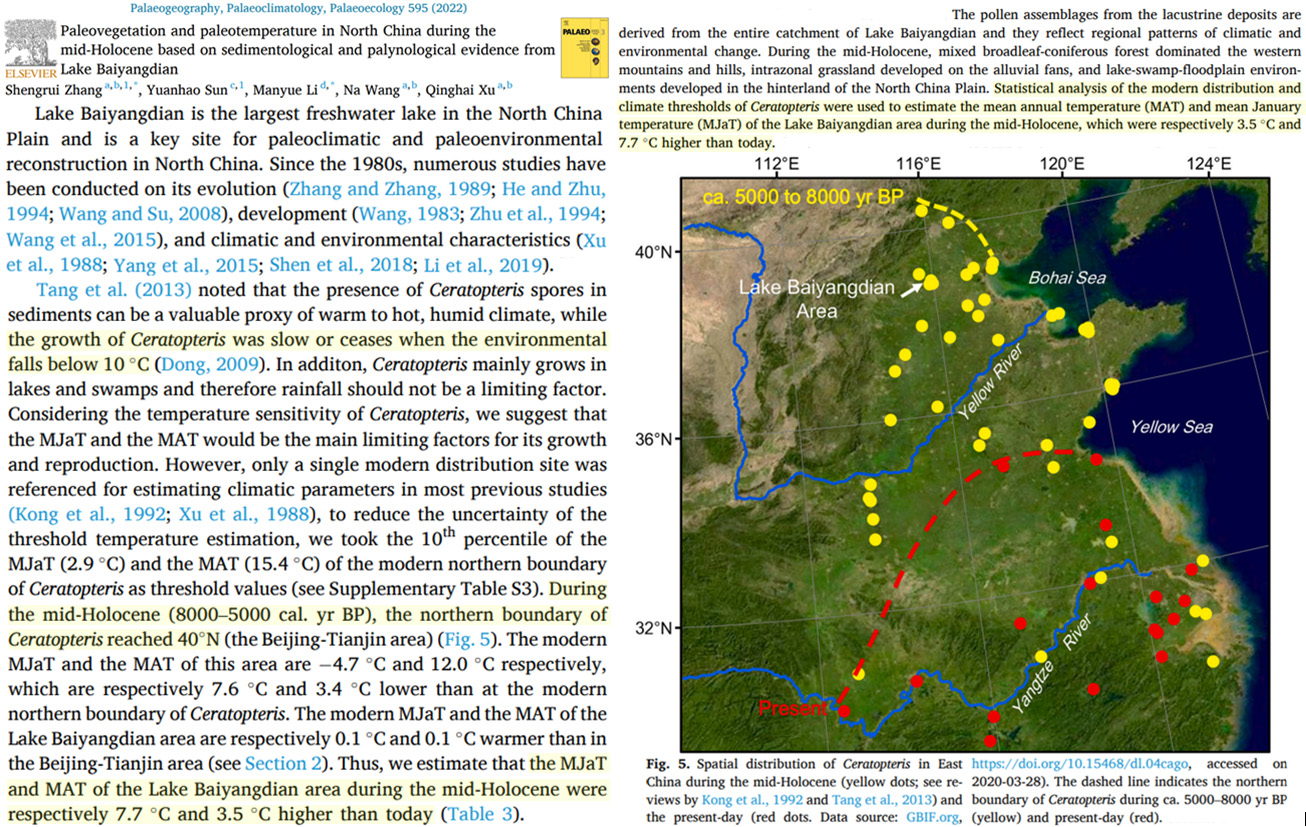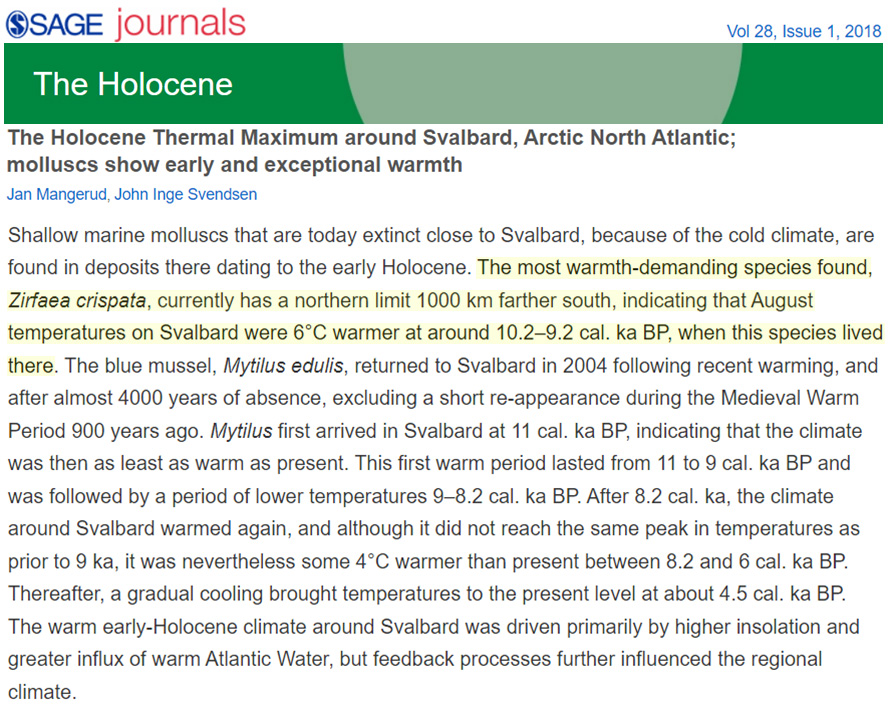A warmth-demanding plant can provide us with solid evidence of a much warmer than today Mid-Holocene climate.
Growth of the tropical aquatic plant 𝐶𝑒𝑟𝑎𝑡𝑜𝑝𝑡𝑒𝑟𝑖𝑠 ceases when air temperatures fall below 10°C.
A new study says that from about 8000 to 5000 years ago it was warm enough in winter that 𝐶𝑒𝑟𝑎𝑡𝑜𝑝𝑡𝑒𝑟𝑖𝑠 could grow at the 40°N latitude in northern China. Today its warmth threshold growth limit is ~34°N.
Scientists can therefore deduce the Mid-Holocene winter temperatures needed to have been “7.7°C higher than today” at that time.

Image Source: Zhang et al., 2022
Another warmth threshold species study allows us to determine Arctic Svalbard needed to have been 6°C warmer than today during the Early Holocene, as molluscs that today can only survive 1000 km south of where they did 9000 years ago affirm the climate was much warmer in the past.
 Image Source:
Image Source: 




[…] A Tropical Plant’s Warmth Threshold Affirms Mid-Holocene Temps Were ‘7.7°C Higher Than … […]
Pardon the nitpick, Kenneth…
“Warmth-demanding plant species can provide us with solid evidence of a much warmer than today Mid-Holocene climate.”
Ceratopteris is a genus, not a species.
https://www.liquisearch.com/ceratopteris
“Ceratopteris is the only genus among homosporous ferns that is exclusively aquatic. It is pan-tropical and classified in the Ceratopteridoideae subfamily of the Pteridaceae.”
Of course, “species” is technically correct in the context of this research, since all 4 (some say 6) species are pan-tropical; so if Ceratopteris spores are found, it won’t matter which species they are from since they all tell the same story – were they are found was very warm when they grew there; i.e., all species of Ceratopteris yield the same result, and species/genus can probably be used interchangeably.
Like I wrote, it’s a nit-pick, which bothered me until I read through it, looked it up and thought about it.
Gotta admire the tenacity of researchers who look for and identify tiny mud born Ceratopteris fern spores and then count them. Makes me cross-eyed just thinking about it. 😬
I prefer accuracy over close-enough, so I’ve removed the word “species” in an edit. Thanks.
“I prefer accuracy over close-enough,…” – K.R.
I thought that was the case. You’re welcome.
Nice finds, as usual.
This is why I found myself being here more often. You are making an excellent job in debunking lots of CAGW huge scientific mishaps with peer reviewed science.
Some other sites tend to mix things with “right” and “far right” stuff that has nothing to do with science.
Lots of these conclusions should have make in into the IPCC AReports. Science is made from plural research and not from “religion like” assessments.
Cheers
John Kerry is looking for you.
[…] Related: A Tropical Plant’s Warmth Threshold Affirms Mid-Holocene Temps Were ‘7.7°C Higher Than Today’ […]
Climate reconstructions are very rough estimates of local climates in the era of 100% natural climate changes. They are irrelevant for the subject of manmade climate changes from greenhouse gases.
In addition. +7.7 degrees C. warmer is very hard to believe.
If one is interested in the global average temperature, it was most likely a few degrees C. warmer than today, during the Holocene Climate Optimum — nowhere close to +7.7degrees C.
Then don’t believe it. Believe whatever you want to.
Thank you for sharing what you believe, Richard. We won’t assume you know better than what warmth-demanding biota tell us.
Climate reconstructions for the Holocene Climate Optimum show a warmer period 5000 to 9000 years ago. I don’t recall any as high as +7.7 degrees C.
Mainstream science says a few degrees C. warmer.
That’s a rough estimate with no real-time measurements.
Not that the Holocene Climate Optimum is relevant today.
”I don’t recall any as high as +7.7 degrees C.” – R.G.
If you are talking about yearly averages, you probably shouldn’t expect to have seen such a high number for a yearly avg., for the time period, but…
”…winter temperatures needed to have been ‘7.7°C higher than today’ at that time.” – K.R. on implications of the study
For those plants to survive in a those locations, it was necessary for WINTER temps to be at least “7.7°C higher than today.”
Your criticism appears to be of an assertion that was not made.
:For those plants to survive in a those locations, it was necessary for WINTER temps to be at least “7.7°C higher than today.”
+77 degrees C. is speculation that may be wrong and is not relevant for the issue of manmade co2 emissions. If the consensus science of a few degrees warmer for the Holocene Climate Optimum is correct, then +7.7 degrees C. in the winter would mean the climate was NOT warmer in the three other seasons. Thag would add up to +2 degrees C. annual average, which is the current consensus. I don’t believe +7.7 degrees C. warmer in the winter and not warmer in the other three seasons.
” +77 degrees C. is speculation…” – R.G.
No. The biology of this genus is well studied and well known, even to the extent of growing them for commercial sale to tropical water garden enthusiasts. One important fact about it is that it will not survive below a known temperature, which in this case happens to be 7.7°C above the lowest current winter temperature in the northern region.
There is no speculation.
If you find it’s spores in the mud, it was growing there, if you don’t it probably wasn’t. If it was growing there, the winters HAD to be warm enough for it to survive. If the current winter temperature is lower than the minimum survival temperature, then the difference must tell you how much warmer it had to have been. If I understand correctly, the study results yield: [T(survival) – minimum T(current)] = 7.7°C
It’s not rocket science.
” I don’t believe +7.7 degrees C. warmer in the winter and not warmer in the other three seasons.” – R.G.
It seems the summers are warm and wet due to the East Asia Summer Monsoon. The winters are dry and cold due to the Northwesterly Monsoon.
https://www.researchgate.net/publication/359775576_Paleovegetation_and_paleotemperature_in_North_China_during_the_mid-Holocene_based_on_sedimentological_and_palynological_evidence_from_Lake_Baiyangdian
I don’t see why they can’t operate independently, with warming in winter being the change they are looking at. If you think that’s insufficient, please support your contention with references.
Also, at this point I don’t know that they have more than 2 seasons. Not everyone does. Regardless, whatever the other season(s) does(do) it is the winters that must be warmer than now. However that occurred, we can’t say. What is obvious is that since those ferns survived there, the winters were warmer then, and by at least the amount indicated.
What you believe is NOT relevant, only the data matters, you seem to reject this information on the basis that its warmer than you want it to have been, however if the data indicated that it was 7.7 Deg C COLDER than now would YOU have rejected it
i doubt it.
Finally…
” +77 degrees C. ….. is not relevant for the issue of manmade co2 emissions.”
If natural warming measurably surpasses any presumed warming due to manmade CO2 emissions, it is the man made CO2 that is irrelevant.
” If the consensus science of a few degrees warmer for the Holocene Climate Optimum is correct, then +7.7 degrees C. in the winter would mean the climate was NOT warmer in the three other seasons.”
In the abstract we read that the +7.7°C was the authors’ estimate of MJaT (mean January temp), and for MAT (mean annual temp) they got +3.5°C (which is close to what you say “consensus science” holds), so I’m not sure what you are getting so upset with them about.
Once again you appear to be arguing about claims that weren’t made.
Also, see table 3 for temperature estimates from this and other papers.
The above was to …
Richard Greene 28. July 2022 at 1:20 AM
[…] science continues to produce evidence of major temperature changes in the past. Two recent studies suggesting much higher temperatures are noted in the No Tricks Zone climate science site. A new […]
I notice that paper estimates the mean annual temperature to be 3.5C higher. It is only the mean January temperature that is estimated to be 7.7C higher. But surely the key point is that this is just one location – part of China. Local variations over thousands of years can be very high. A global average change of 7.7C would be enormous. The last ice age was only about 5C colder than present.
[…] en el pasado. El sitio de ciencias climáticas No Tricks Zone señala dos estudios recientes que sugieren temperaturas mucho más altas . Se dice que un nuevo estudio demostró que hace […]
[…] de temperatura en el pasado. El sitio de ciencias climáticas No Tricks Zone señala dos estudios recientes que sugieren temperaturas mucho más altas . Se dice que un nuevo estudio demostró que hace 8.000 a […]